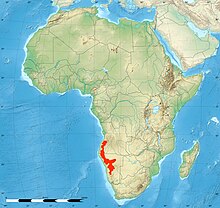Python (일반)
Python (genus)| 파이썬 시간 범위: | |
|---|---|
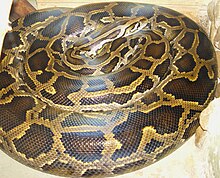 | |
| 버마 비단뱀(Python bivittatus) | |
| 과학적 분류 | |
| 왕국: | 애니멀리아 |
| 문: | 챠다타 |
| 클래스: | 파충류 |
| 주문: | 스쿼마타 |
| 서브오더: | 독사 |
| 패밀리: | 비단뱀과 |
| 속: | 파이썬 다우딘, 1803년 |
| 모식종 | |
| 비단뱀몰루루스[필요한 건] 린네, 1758년 | |
| 동의어 | |
Python은 Pythonidae과에 속하는 제한성 뱀의 [1]속으로서 동반구의 열대 및 아지트로픽이 원산입니다.
파이썬이라는 이름은 1803년 프랑수아 마리 도댕이 독이 없는 반점 [2]뱀을 위해 제안한 것입니다.현재 10종의 비단뱀이 유효한 [3]분류군으로 인정되고 있다.
이전에는 비단뱀 아종으로 여겨지던 3종이 승격되어 새로운 종이 발견되었다.
분류법
총칭 파이썬은 1803년 프랑수아 마리 도댕이 피부 반점과 [2]혀가 갈라진 독이 없는 뱀을 위해 제안한 것입니다.
1993년에는 7종의 비단뱀이 유효한 [4]분류군으로 인정되었다.계통발생학적 분석에 근거해 7~13종의 비단뱀이 [5][6]인정되고 있다.
| 종. | 이미지 | IUCN 적색 목록 및 지리적 범위 |
|---|---|---|
| 인도 비단뱀 (P. molurus) (Linnaeus, 1758)[7] | 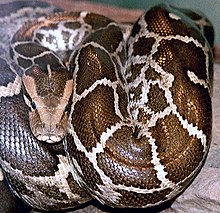 | NT[8] |
| 중앙아프리카산 비단뱀 (P. sebae) (Gmelin, 1788)[9] |  | NT[10] |
| 비단뱀 (P. regius) (쇼, 1802)[11] | 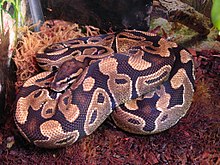 | NT[12] |
| 버마 비단뱀 (P. bivittatus) (Kul, 1820)[13] |  | VU[14]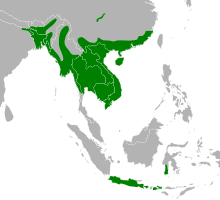 |
| 남아프리카산 바위 비단뱀(P. natalensis) (Smith, 1833)[15] | 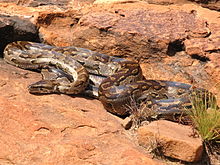 | LC[16] |
| 수마트라 짧은꼬리 비단뱀 (P. curtus) (Schlegel,[17] 1872년 |  | LC[18] 태국 남부, 말레이시아 반도(페낭 포함) 및 인도네시아(수마트라, 리아우 군도, 링가 제도, 방카 제도 및 멘타와이 제도)[18]의 동남아시아. |
| 보르네오 비단뱀 (P. breitensteini) (Steindachner, 1881)[19] |  | LC[20] |
| 앙골라 비단뱀 (P. anchietae) (Bocage, 1887) |  | LC[21] |
| 브롱거스마의 짧은 꼬리 비단뱀(P. brongersmai) (Stull, 1938년) (구 P. curtus brongersmai) |  | LC[22] |
| 미얀마 비단뱀 (P. kyktiyo) (Zug, Gotte & Jacobs, 2011)[23] |  | VU[24] |
| † Python europaeus (Syndlar & Rage, 2003)[25] | EX |
분포 및 서식
아프리카에서 비단뱀은 사하라 남쪽의 열대지방에 서식하지만, 남아프리카의 남서쪽 끝(웨스턴 케이프)이나 마다가스카르에는 서식하지 않습니다.아시아에서는 니코바르 제도를 포함한 방글라데시, 네팔, 인도, 파키스탄, 스리랑카에서 미얀마를 거쳐 동쪽으로 인도차이나, 중국 남부, 홍콩, 하이난, 인도네시아와 [1]필리핀의 말레이 지역에서 발견된다.
침습적
어떤 사람들은 P. bivittatus와 P. sebae가 플로리다 [26]남부에서 문제가 있는 침입종일 가능성을 시사한다.2016년 초, 106마리의 비단뱀을 도태시킨 후, 에버글레이즈 국립공원 관계자들은 "수천마리"가 공원 내에 살며, 이 종은 몇 년 동안 그곳에서 번식하고 있다고 제안했다.더 최근의 데이터는 이 비단뱀들이 플로리다 북쪽의 겨울 기후를 견디지 못할 것이라는 것을 암시하고 있는데, 이는 지리적으로 더 중요한 잠재적 [27]범위를 시사하는 이전의 연구와 배치된다.
사용하다
파이썬 스킨은 조끼, 벨트, 부츠, 신발과 같은 옷이나 핸드백과 같은 패션 액세서리를 만드는데 사용된다.얼후 스파이크 피들, 삼현,[28][29] 산신루트와 같은 현악기의 사운드 보드로 늘어나 형성될 수도 있다.현재 패션업계에서 뱀 가죽에 대한 수요가 높기 때문에 아프리카와 남아시아 국가들은 비단뱀 가죽의 합법적 및 불법 판매에 참여하고 있다.소비자들을 위해 매우 많이 팔리는 상품으로 사냥꾼들에게 매우 낮은 임금을 제공하면서, 뱀 [30]가죽 거래의 시작과 끝 사이에는 엄청난 차이가 있다.
애완동물로
P. regius, P. brongersmai, P. bivittatus, M. reticulatus와 같은 많은 파이썬 종들은 그들의 손쉬운 보살핌, 온순한 기질, 그리고 선명한 색 때문에 애완동물로 기르기에 인기가 있으며, 몇몇 희귀한 돌연변이들은 수천 달러에 팔려왔다.애완동물 거래의 비단뱀은 야생에서, 혹은 야생에서 데려온 포획된 암컷으로부터, 또는 그들 자신이 포획된 환경에서 태어난 부모로부터 유래한다. 언론 보도에서 제기된 논란에도 불구하고, 적절한 안전 절차와 함께, 비단뱀은 상대적으로 [32][33]소유하기에 안전하다.
어원학
'피톤'이라는 단어는 라틴어 '프톤'과 그리스어 '프톤'에서 유래했으며, 둘 다 "신화에 따르면 델파이 근처에서 아폴로에게 승리한 기념으로 피티우스로 불렸다고 전해진다"[34]를 가리킨다.
레퍼런스
- ^ a b McDiarmid, R. W.; Campbell, J. A.; Touré, T. (1999). "Python". Snake Species of the World: A Taxonomic and Geographic Reference. Volume 1. Washington, DC: Herpetologists' League. ISBN 1893777014.
- ^ a b Daudin, F. M. (1803). "Python". Histoire naturelle, générale et particulière, des reptiles. Tome 8. Paris: De l'Imprimerie de F. Dufart. p. 384.
- ^ Barker, D. G.; Barker, T. M.; Davis, M. A.; Schuett, G. W. (2015). "A review of the systematics and taxonomy of Pythonidae: an ancient serpent lineage". Zoological Journal of the Linnean Society. 175 (1): 1−19. doi:10.1111/zoj.12267.
- ^ Kluge, A. G. (1993). "Aspidites and the phylogeny of pythonine snakes". Records of the Australian Museum (Supplement 19): 1–77.
- ^ Lawson, R.; Slowinski, J. B.; Burbrink, F. T. (2004). "A molecular approach to discerning the phylogenetic placement of the enigmatic snake Xenophidion schaeferi among the Alethinophidia". Journal of Zoology. 263 (3): 285–294. doi:10.1017/s0952836904005278.
- ^ Reynolds, R. G.; Niemiller, M. L.; Revell, L. J. (2014). "Toward a tree-of-life for the boas and pythons: multilocus species-level phylogeny with unprecedented taxon sampling". Molecular Phylogenetics and Evolution. 71 (71): 201–213. doi:10.1016/j.ympev.2013.11.011. PMID 24315866.
- ^ Linnaeus, C. (1758). "Coluber molurus". Systema naturae per regna tria naturae: secundum classes, ordines, genera, species, cum characteribus, differentiis, synonymis, locis. Vol. 1 (Tenth reformed ed.). Holmiae: Laurentii Salvii. p. 225.
- ^ Aengals, A.; Das, A.; Mohapatra, P.; Srinivasulu, C.; Srinivasulu, B.; Shankar, G. & Murthy, B.H.C. (2021). "Python molurus". IUCN Red List of Threatened Species. 2021: e.T58894358A1945283. Retrieved 2 December 2021.
- ^ Gmelin, J. F. (1788). "Coluber sebae". Caroli a Linné. Systema naturae per regna tria naturae: secundum classes, ordines, genera, species, cum characteribus, differentiis, synonymis, locis. Vol. I, Part III (13., aucta, reformata ed.). Lipsiae: Georg Emanuel Beer. p. 1118.
- ^ Alexander, G.J.; Tolley, K.A.; Penner, J.; Luiselli, L.; Jallow, M.; Segniagbeto, G.; Niagate, B.; Howell, K.; Beraduccii, J.; Msuya, C.A. & Ngalason, W. (2021). "Python sebae". IUCN Red List of Threatened Species. 2021: e.T13300572A13300582. Retrieved 2 December 2021.
- ^ Shaw, G. (1802). "Royal Boa". General zoology, or Systematic natural history. Volume III, Part II. London: G. Kearsley. pp. 347–348.
- ^ D'Cruze, N.; Wilms, T.; Penner, J.; Luiselli, L.; Jallow, M.; Segniagbeto, G.; Niagate, B. & Schmitz, A. (2021). "Python regius". IUCN Red List of Threatened Species. 2021: e.T177562A15340592. Retrieved 2 December 2021.
- ^ Kuhl, H. (1820). "Python bivittatus mihi". Beiträge zur Zoologie und vergleichenden Anatomie. Frankfurt am Main: Verlag der Hermannschen Buchhandlung. p. 94.
- ^ Stuart, B.; Nguyen, T.Q.; Thy, N.; Grismer, L.; Chan-Ard, T.; Iskandar, D.; Golynsky, E. & Lau, M.W. (2019) [errata version of 2019 assessment]. "Python bivittatus". IUCN Red List of Threatened Species. 2019: e.T193451A151341916. Retrieved 6 April 2021.
- ^ Smith, A. (1849). "Python natalensis". Illustrations of the zoology of South Africa : consisting chiefly of figures and descriptions of the objects of natural history collected during an expedition into the interior of South Africa, in the years 1834, 1835, and 1836; fitted out by "the Cape of Good Hope Association for exploring Central Africa" : together with a summary of African zoology, and an inquiry into the geographical ranges of species in that quarter of the globe. London: Smith, Elder and Co. pp. 42–44.
- ^ Alexander, G.J. & Tolley, K.A. (2021). "Python natalensis". IUCN Red List of Threatened Species. 2021: e.T13300560A13300564. Retrieved 19 April 2022.
- ^ Schlegel, H. (1872). "De Pythons". In Witkamp, P. H. (ed.). De Diergaarde van het Koninklijk Zoölogisch Genootschap Natura Artis Magistra te Amsterdam: De Kruipende Dieren. Amsterdam: Van Es. pp. 53–54.
- ^ a b Inger, R.F.; Iskandar, D.; Lilley, R.; Jenkins, H. & Das, I. (2014). "Python curtus". IUCN Red List of Threatened Species. 2014: e.T192244A2060581. Retrieved 2 December 2021.
- ^ Steindachner, F. (1880). "Über eine neue Pythonart (Python breitensteini) aus Borneo". Sitzungsberichte der Kaiserlichen Akademie der Wissenschaften Wien. 82: 267−280.
- ^ a b Inger, R.F.; Iskandar, D.; Lilley, R.; Jenkins, H.; Das, I. (2012). "Python breitensteini". IUCN Red List of Threatened Species. 2012: e.T192013A2028005. Retrieved 2 December 2021.
- ^ a b Baptista, N.; Becker, F.; Conradie, W.; Bauer, A.M. & Ceríaco, L.M.P. (2021). "Python anchietae". IUCN Red List of Threatened Species. 2021: e.T177539A120594491. Retrieved 2 December 2021.
- ^ a b Grismer, L. & Chan-Ard, T. (2012). "Python brongersmai". IUCN Red List of Threatened Species. 2012: e.T192169A2050353. doi:10.2305/IUCN.UK.2012-1.RLTS.T192169A2050353.en. Retrieved 13 March 2018.
- ^ Zug, G. R.; Gotte, S. W.; Jacobs, J. F. (2011). "Pythons in Burma: Short-tailed python (Reptilia: Squamata)". Proceedings of the Biological Society of Washington. 124 (2): 112−136. doi:10.2988/10-34.1. S2CID 86424371.
- ^ a b Wogan, G. & Chan-Ard, T. (2012). "Python kyaiktiyo". IUCN Red List of Threatened Species. 2012: e.T199854A2614411. doi:10.2305/IUCN.UK.2012-1.RLTS.T199854A2614411.en. Retrieved 13 March 2018.
- ^ a b Szyndlar, Z.; Rage, J. C. (2003). "Python europaeus". Non-erycine Booidea from the Oligocene and Miocene of Europe. Kraków: Institute of Systematics and Evolution of Animals. pp. 68−72.
- ^ "Python Snakes, An Invasive Species In Florida, Could Spread To One Third Of US". ScienceDaily. 2008. Retrieved 2017-08-01.
- ^ Avery, M. L.; Engeman, R. M.; Keacher, K. L.; Humphrey, J. S.; Bruce, W. E.; Mathies, T. C.; Mauldin, R. E. (2010). "Cold weather and the potential range of invasive Burmese pythons". Biological Invasions. 12 (11): 3649−3652. doi:10.1007/s10530-010-9761-4. S2CID 2060365.
- ^ http://erhuworld.com/
- ^ "Archived copy". Archived from the original on 2016-08-21. Retrieved 2015-04-08.
{{cite web}}: CS1 maint: 제목으로 아카이브된 복사(링크) - ^ Wahab; Maulany, R. I.; Nasri & Nirsyawita (2020). "Hunting and trading activities of reticulated python (Python reticulatus) in South Sulawesi, Indonesia: A report from the field". IOP Conference Series. Earth and Environmental Science. 486 (1): 12029–. Bibcode:2020E&ES..486a2029W. doi:10.1088/1755-1315/486/1/012029. S2CID 219739375.
- ^ Nijman, Vincent (2022-11-05). "Harvest quotas, free markets and the sustainable trade in pythons". Nature Conservation. 48: 99–121. doi:10.3897/natureconservation.48.80988. ISSN 1314-3301. S2CID 248733239.
- ^ "Malayopython reticulatus".
- ^ "Playing with the Big Boys: Handling Large Constrictors". www.anapsid.org. Retrieved 2017-08-01.
- ^ Lewis, C. T.; Short, C. (1879). "Pȳthon". A Latin Dictionary. Oxford: Clarendon Press.
외부 링크
- Python은 Reptarium.cz 파충류 데이터베이스에 있습니다.2007년 9월 11일에 액세스.
